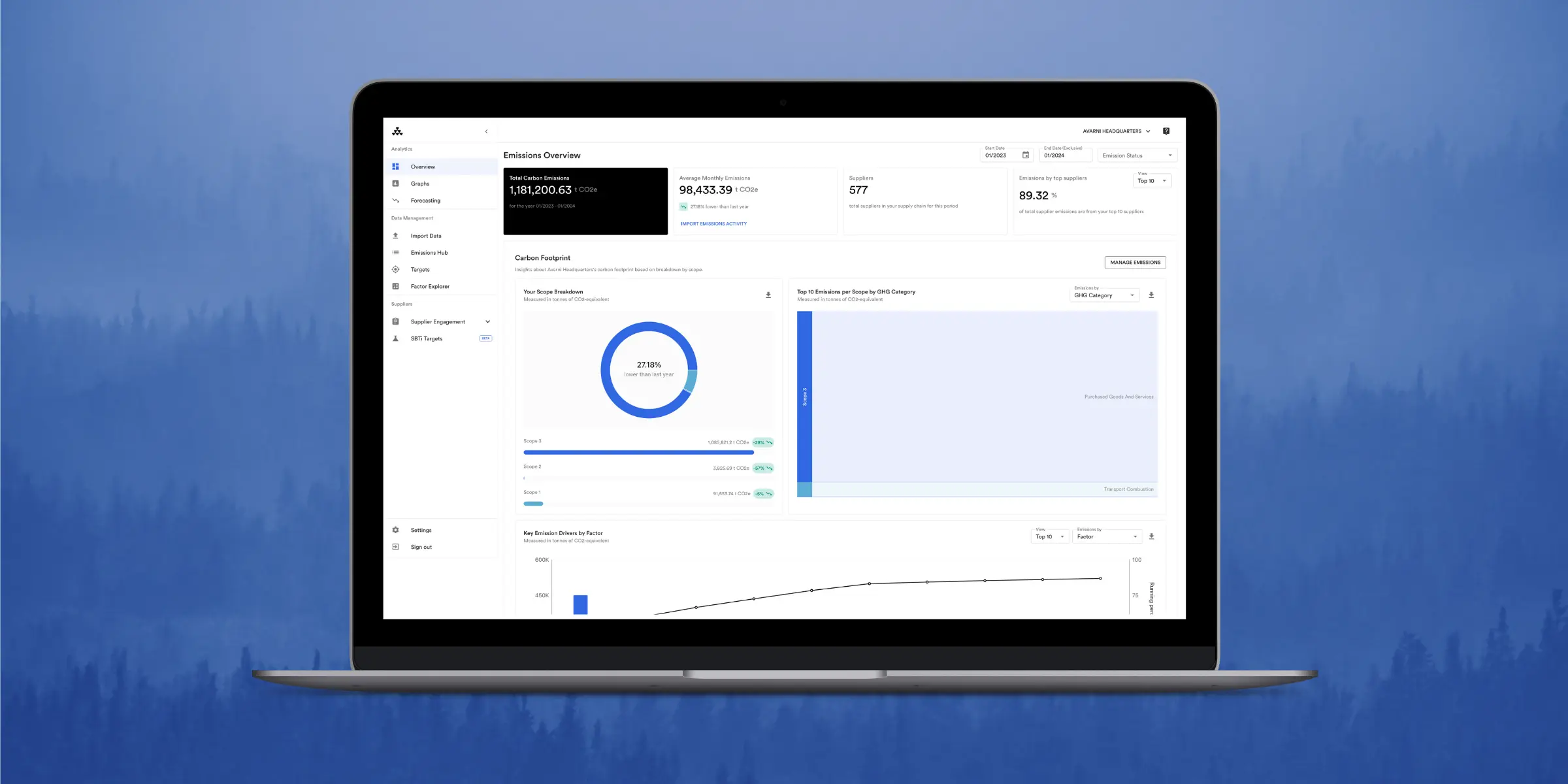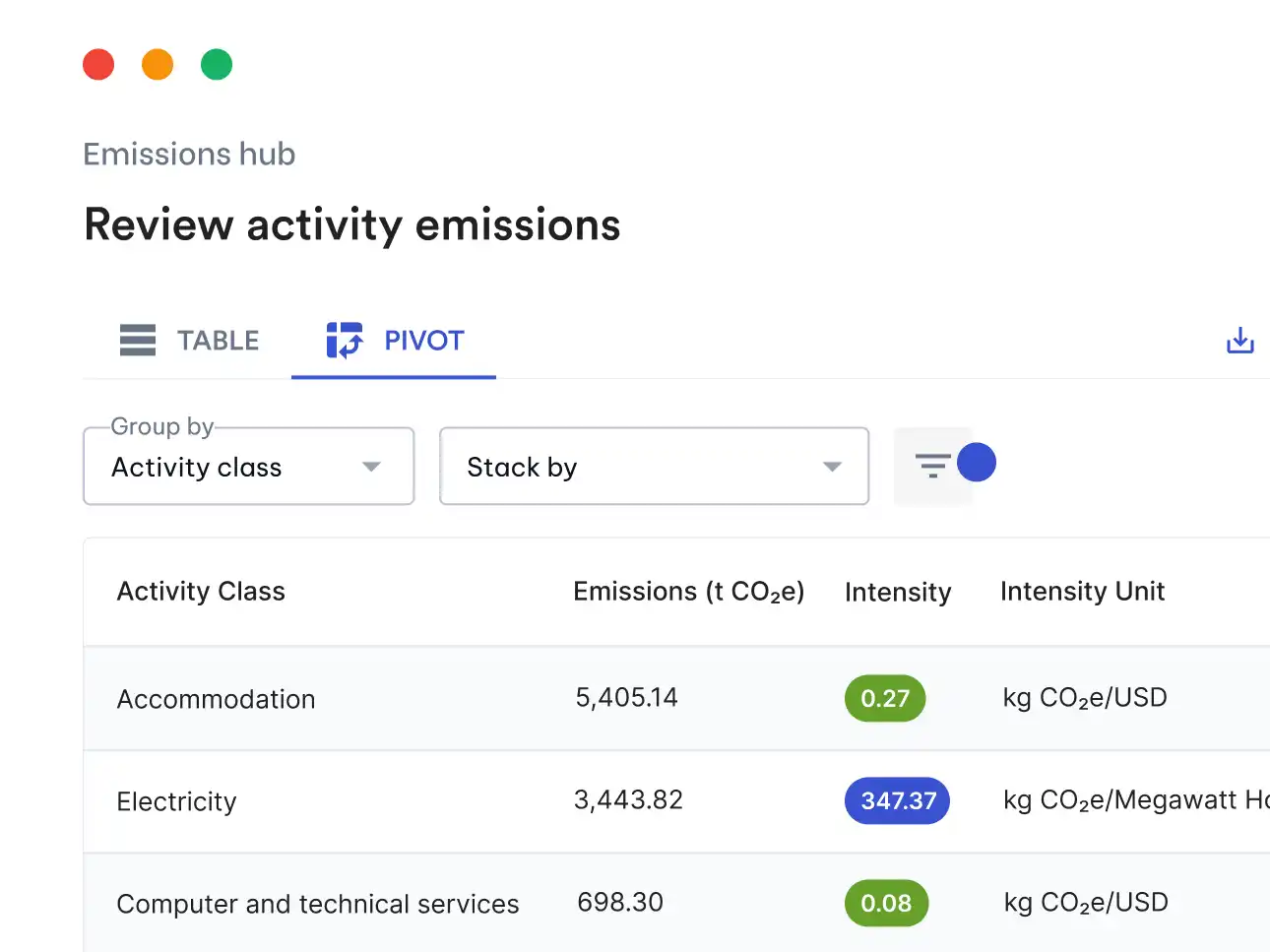Climate reporting is now a compliance issue—not a side project. With the Australian Sustainability Reporting Standards (ASRS) now fully in force, businesses are expected to integrate climate data directly into their financial disclosures under AASB S2.
That’s a major shift. AASB S2, aligned with the ISSB framework, requires accurate emissions data, transparency in calculation methods, and audit-ready documentation. The days of managing climate reporting with spreadsheets and basic carbon calculators are over. What’s needed now is an integrated emissions tracking platform that finance, sustainability, and audit teams can all rely on.
This isn’t just about meeting new standards. The right environmental reporting platform can reduce manual workload, unlock real-time insight into your value chain emissions, and enable faster decision-making. It can also help you avoid some of the most common compliance pitfalls — like inconsistent methodologies, missing documentation, or hard-to-verify Scope 3 data.
In this guide, we break down what to look for when choosing a corporate sustainability software solution that’s built for ASRS compliance, and built for scale.
What ASRS compliance really requires from your climate platform
AASB S2 requires climate disclosures to be embedded in financial reporting, with the same audit and assurance requirements as other material risks (source). That’s a big leap for many organisations still relying on siloed tools or consultants to manually compile reports.
ASRS-ready software needs to be more than a calculator. It must manage emissions data, support cross-team collaboration, and generate reports that align directly with AASB S2 requirements.
Get your data house in order
Reliable climate reporting starts with data infrastructure. The software you choose needs to collect and centralise climate-related data from multiple business units, sites, and geographies. Integration with ERP and financial systems like Xero, MYOB, or SAP is essential to maintain consistency between operational and financial data.
Without seamless integration, data inconsistencies quickly become an audit liability. A robust platform will reduce manual data handling while supporting both numerical and narrative data.
Start with solid emissions groundwork
GHG emissions reporting is at the core of AASB S2. Your platform should accurately calculate Scope 1, 2, and 3 emissions using the latest methodologies and emissions factors. Scope 3 coverage is especially important given its inclusion in the standard, even with a one-year relief period.
You’ll also need full documentation to support every calculation. That means audit trails, source references, emission factor transparency, and clear assumptions.
Build reports that stand up to scrutiny
It’s not enough to calculate emissions. You have to report them in a way that meets disclosure standards. Your platform should allow you to generate ASRS-aligned reports, support comparability across reporting periods, and provide the documentation required for external assurance.
Platforms like Avarni are designed to do exactly that, with automation features and assurance-ready outputs built in.
Why a carbon calculator won’t cut it under ASRS
Basic carbon footprint tools can estimate emissions, but they weren’t built to deliver regulatory compliance. AASB S2 requires more: deep data coverage, platform integration, assurance documentation, and flexible reporting capabilities (source).
Here’s what that difference looks like in practice:
End-to-end software built for this moment
Avarni goes far beyond footprint estimation. It supports full-scope emissions tracking, automation across data sources, spend classification, and flexible report generation, all in a single system. The result is audit-ready, regulator-aligned reporting without needing to patch together multiple tools.
What you’ll miss if you stick with basic tools
Tools built only for emissions estimation lack the integration, documentation, and flexibility needed for compliance. Organisations relying on basic calculators will need to manually supplement data, rebuild reports, and address audit concerns separately, costing time, accuracy, and assurance confidence.
Let automation do the heavy lifting
Manual reporting processes don’t scale and they introduce error risk. Modern climate reporting platforms solve this by automating data collection, classification, and processing.
Connect emissions directly to your business activity
Your climate platform should pull financial and operational data directly from your accounting and ERP systems. That ensures your emissions calculations reflect actual business activity, not approximations. It also eliminates the risks associated with manual data uploads.
Classify and calculate with machine learning accuracy
Avarni uses machine learning to classify thousands of business purchases and apply the appropriate emissions factors, including company-specific values. This cuts manual effort and boosts accuracy, especially across Scope 3 categories.
Transform bills and invoices into audit-ready data
OCR functionality allows the platform to extract consumption data from utility bills, supplier invoices, and fuel receipts automatically. Instead of uploading PDFs or entering data by hand, teams get structured, standardised data ready for reporting and assurance.
Be ready when the auditors come knocking
With ASRS, climate disclosures must meet the same level of rigour as financial statements. That means traceability, defensible assumptions, and clear internal controls.
Get scopes 1, 2 and 3 right down to the details
Your platform must align with the GHG Protocol and use Australian-specific emissions factors from the Department of Industry, Science and Resources. Relying on generic global averages risks non-compliance and undermines the credibility of your report.
Prove every number, back every claim
Every step in your calculation, from data input to final emissions figure, needs to be traceable. That includes emission factors, transformation steps, and any assumptions used. Avarni automatically generates audit trails to support this level of transparency.
Control your climate data like financials
Look for software that supports version control, role-based access, and approval workflows. This enables teams to collaborate on disclosures without compromising data integrity or oversight.
Cover ASRS, CDP, ISSB and TCFD without duplicating effort
Multi-framework alignment means your platform should support ASRS and international disclosure standards using the same dataset. This avoids duplicated work and improves consistency across all stakeholder reports.
Tackle scope 3 with scale, accuracy and confidence
Scope 3 is typically the largest and most difficult part of your carbon footprint. In many industries, it accounts for over 70% of emissions (source). Managing it well requires automation, structure, and the right data infrastructure.
Make scope 3 easier for your supply chain, too
Supplier data collection doesn’t have to be a manual nightmare. Leading platforms use supplier portals, automated data requests, and standardised templates to streamline engagement and improve response rates.
Smarter estimates today, better data tomorrow
Until suppliers provide primary data, spend-based calculations fill the gap. Avarni enhances this with machine learning and company-specific emissions factors, dramatically improving accuracy over generic industry estimates.
Cover all 15 categories without the chaos
Scope 3 includes 15 different emissions categories: from purchased goods to business travel to end-of-life treatment. Your software should help you identify which ones matter most for your business, so you can focus on material categories and streamline your approach.
Track accuracy and show you’re improving
Data quality scoring across suppliers and categories gives you a roadmap for better reporting over time. That’s especially critical as Scope 3 becomes mandatory in your second reporting year under ASRS.
Use climate data to drive smarter business decisions
The most valuable climate platforms don’t stop at compliance. They help your business make better decisions by translating emissions data into insights you can act on.
Model the impact of today’s decisions on tomorrow’s emissions
Scenario planning tools allow you to forecast emissions impacts of decisions like supplier changes, geographic shifts, or facility expansions (source). This helps you align operational strategy with climate targets.
Move from measurement to meaningful action
Avarni tracks decarbonisation progress over time and identifies emissions hotspots to focus your reduction efforts. This helps your team turn measurement into momentum.
Bring carbon into capital planning
By linking emissions data to cost and performance metrics, platforms help finance leaders evaluate the implications of carbon pricing, supply chain decisions, or investment strategies.
Know where you stand and where to go next
Benchmarking tools let you compare performance against industry peers or science-based targets. Real-time dashboards keep leadership informed and enable proactive course corrections.
Choose software your whole team can actually use
ASRS compliance is a cross-functional effort. Your software should be intuitive enough for everyone to use, from sustainability analysts to finance managers to board executives.
Make climate insights accessible to everyone
Clear dashboards, role-based access, and interactive visualisations make emissions data easy to explore and understand, even for non-technical stakeholders.
Build reports for auditors, boards, and customers
Look for platforms that offer flexible output formats. Whether it’s a technical appendix for auditors or a polished summary for investors, the software should be able to generate it on demand.
Pick a platform that’s ready for what’s next
ASRS is just the start. Your software needs to adapt as reporting requirements evolve, whether that’s expanded Scope 3 categories, value chain disclosures, or new international alignment expectations (source).
Summary
- ASRS compliance requires more than emissions estimates, it demands integrated, audit-ready platforms that support data consistency, transparency, and reporting.
- Basic carbon tools often fall short when it comes to assurance support, Scope 3 management, and cross-platform integration.
- Avarni’s climate reporting platform automates data collection, classification, and reporting, making it easier to comply with AASB S2.
- Scope 3 emissions can be managed at scale through supplier engagement tools, smart calculations, and data quality tracking.
- Strategic features like scenario forecasting and decarbonisation tracking turn compliance into business value.
- User experience and future readiness ensure the platform supports both technical and executive users as standards evolve.
Looking for a platform that delivers real compliance and real insights?
Talk to us about how we can support your ASRS reporting.





